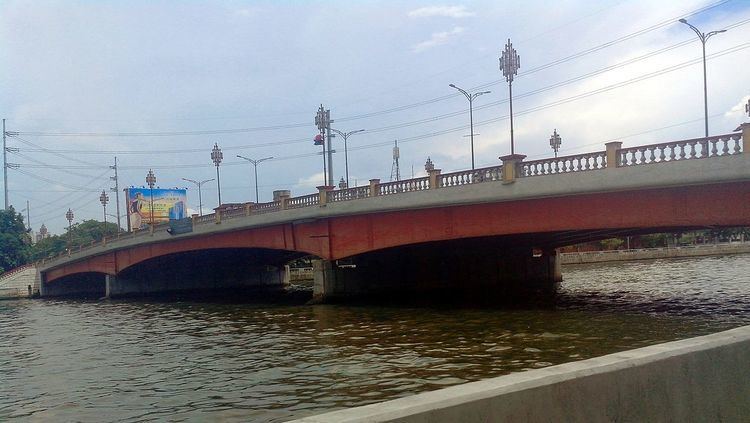Architect Juan M. Arellano | Rebuilt 1945 | |
 | ||
Carries Vehicular and pedestrian traffic Official name William A. Jones Memorial Bridge Followed by Del Pan Bridge (renamed as Roxas Bridge) Similar | ||
The William A. Jones Memorial Bridge is a bridge that spans the Pasig River in the Philippines connecting the Manila area of Binondo on Rosario Street (Calle Rosario, now Quintin Paredes Street), with the center of city in Ermita. The previous bridge that connected the two areas was the Puente Grande (Great Bridge), later called the Puente de España (Bridge of Spain) located one block upriver on Nueva Street (Calle Nueva, now E. T. Yuchengco Street). That span was considered as the oldest established in the Philippines.
Contents
Pre-World War II
After the Puente de España suffered from wear and tear beyond repair, construction of a replacement bridge was planned. A new bridge was constructed beside the Puente de España which remained in use until the newer bridge's completion. The new bridge was named as the Jones Bridge after former Virginia Rep. William Atkinson Jones, who was the principal author of the Philippine Autonomy Act of 1916. The bridge's construction fully commenced in 1919 by the City Government of Manila but the American colonial government took over to finish the bridge in 1920. Jones Bridge was inaugurated in 1921.
The Neoclassical design by Juan M. Arellano was an ornate concrete arch bridge. The bridge was patterned afte the style of bridges in Paris during the Napoleonic and Haussman eras. The bridge had three arches resting on two piers. The piers' interior was reinforced with Steel while the cladding and ornamental designs were made in concrete and pre-cast faux stone.
Arellano placed a statuary of boys on dolphins in the piers which is similar to the Pont Alexandre III in Paris, which Arellano saw himself on a trip back in the Philippine islands from the United States. Other elements of the bridge such as the balustrads, finials, lamp posts and moldings are likewise heavily ornamented. Statuary on plinths were also placed on both ends of the Jones Bridge. A sculptor named Martinez was commissioned to create four allegorical tableaus which shared the similar theme of motherhood and nationhood.
The bridge was left heavily damaged after the Japanese bombed it during the World War II. After the war a bailey bridge was temporarily used until the bridge could be repaired.
Post-World War II
After the war, the bridge was reconstructed by the U.S. Bureau of Public Roads and then Philippine Bureau of Public Works under the Philippine Rehabilitation Act of 1945. Carrying the name of the bridge, the new span was a simple bridge with metal pole railings, bare in design. The war also lost one of the four La Madre Filipina statues; the surviving monuments were moved to other locations in Manila. Two of them now stand near the steps of the Court of Appeals Building while one was moved to Rizal Park.
Present state
Jones Bridge is one of the busiest bridges in the country. Some recent improvements on the current bridge were the addition of street lamps and replacing the old pole railings with stone railings reminiscent of the first Jones Bridge.
